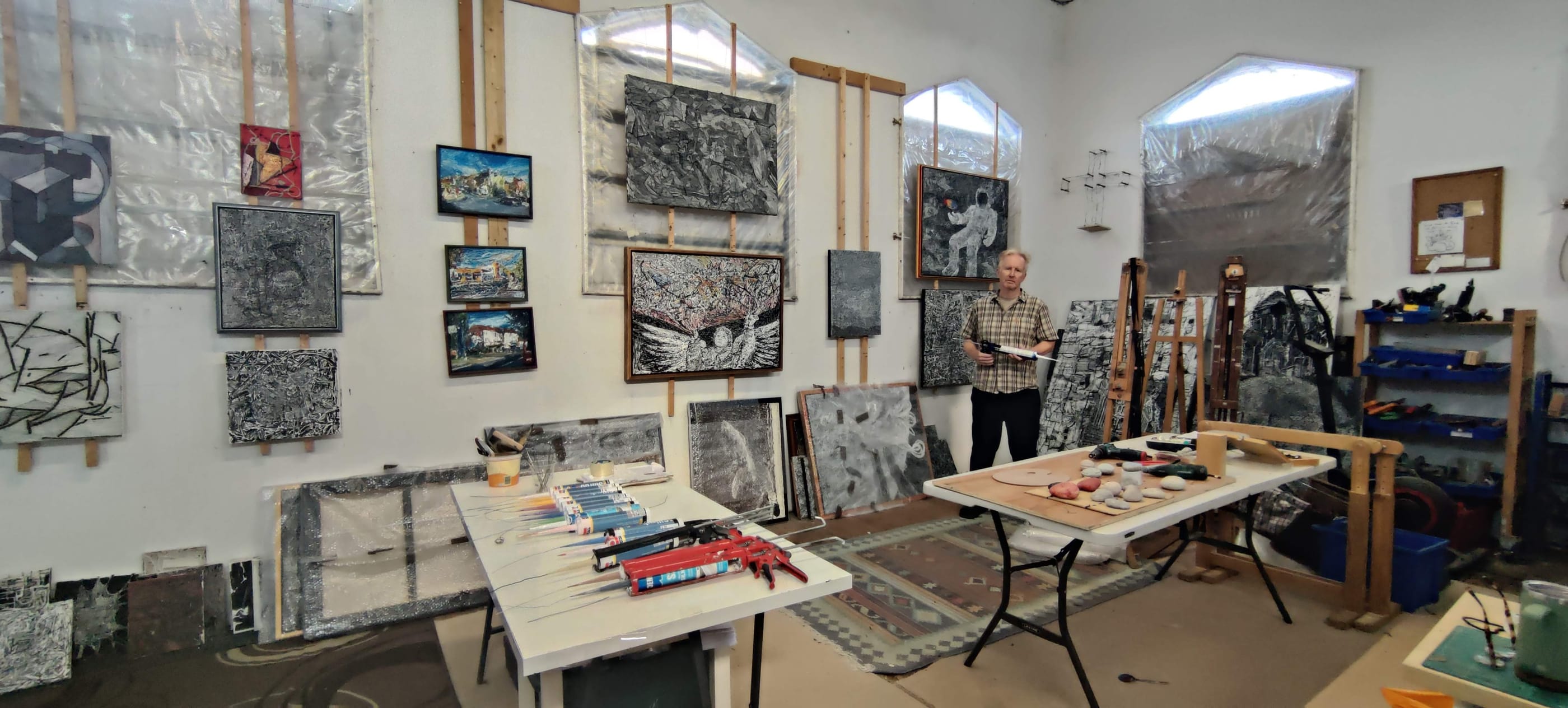Beautiful, strange and otherworldly creations in silicone. The tools we need to create art are all around us.
We discovered Walter's work at the Jeannie Avent gallery in Dulwich. When we entered the charming space, we were welcomed by a genial fellow, sitting at a table beside the tools of their trade - silicone guns, lined up like he was in there to do the grouting. Walter Hayn was not a tradesman doing his bits, he was the exhibiting artist. Walter Hayn's pieces are transmissions from somewhere else, unknown. Dense, layered creations baring a monochrome topography that we want to run our fingers over and explore. Abstract images - whales, cosmonauts, Coelacanths, rippling through undulating silicone lines.
Walter Hayn's pieces are transmissions from somewhere else, unknown.
After burning through our lunch hour with a wonderful chat about Walter's art, his technique and his voice we just knew we had to bring the work and the story to you all. So here we go! Enjoy...
Walter! Thank you so much for your time. Let's start as we always do and go to back to beginning. May you please tell us about your creative journey so far?
I was born into the Apartheid bubble of South Africa, during the 60’s, in which a white population was favoured with superior education and opportunity, and where every other race, (Mostly Black Africans, but also Asian and Mixed-Race peoples), were treated as second class citizens by the white Afrikaner regime.
In 1994 when Nelson Mandela had been released from prison to become the first Black president, I remember my sense of relief that my country, a pariah in the eyes of the world, had finally been reborn and embraced by the rest of Africa. By then I had completed my education, including two years of national military service which was then compulsory for all (and only) young white males, and a four-year course in Fine Art at the Durban University of Technology (then Technikon Natal), but I still hadn’t quite worked out who I was. My father, an East German immigrant, had twice been a refugee, and my mother had a Scottish and English heritage. Growing up in South Africa where the white population had tried to mimic a European lifestyle, I wasn’t at all comfortable calling myself ‘African’ nor for that matter, ‘European’. I grieved that the Apartheid regime had denied me all the richness of integrating with my African brethren, and of knowing myself as a true African.
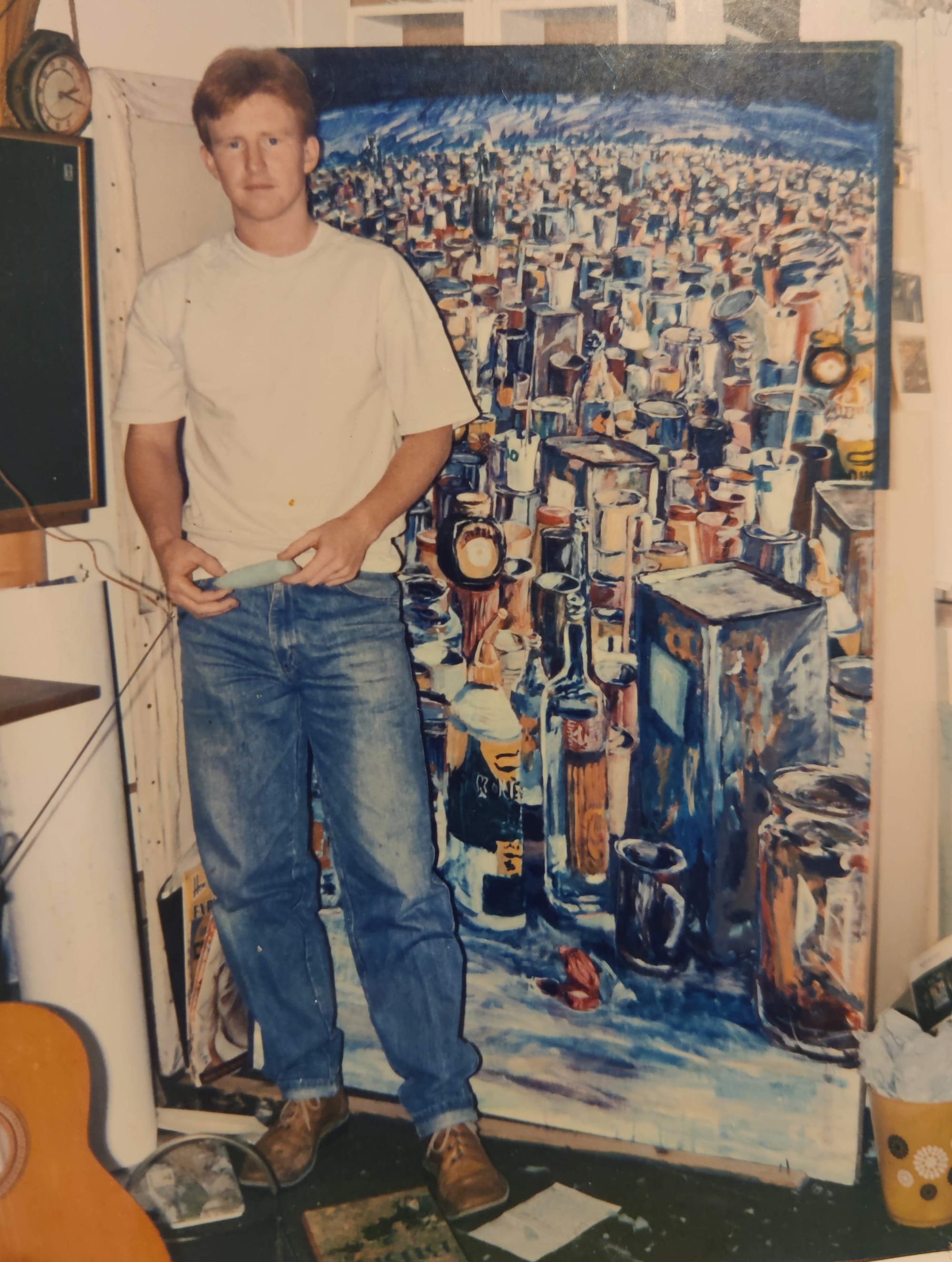

Over the years that followed I continued to work at making art in the suburbs of Durban, the coastal city of my birth, gathering a body of new paintings together, whilst also taking part in various group shows. A studio residency grant of eighteen months in 1993, provided the seminal time that I needed to focus on my painting at a crucial period of my life. Concurrently painting in earnest, I produced a series of forty woodcut prints depicting the life of Christ which helped to make sense of my own identity. Many Black ‘Resistance Artists’, whose work I admired, had worked in woodcut, and similarly, my German heritage had ties to a long tradition in the craft. Much of my current work in black and white silicone rubber I still attribute to the aesthetic of those early black and white woodcut prints.

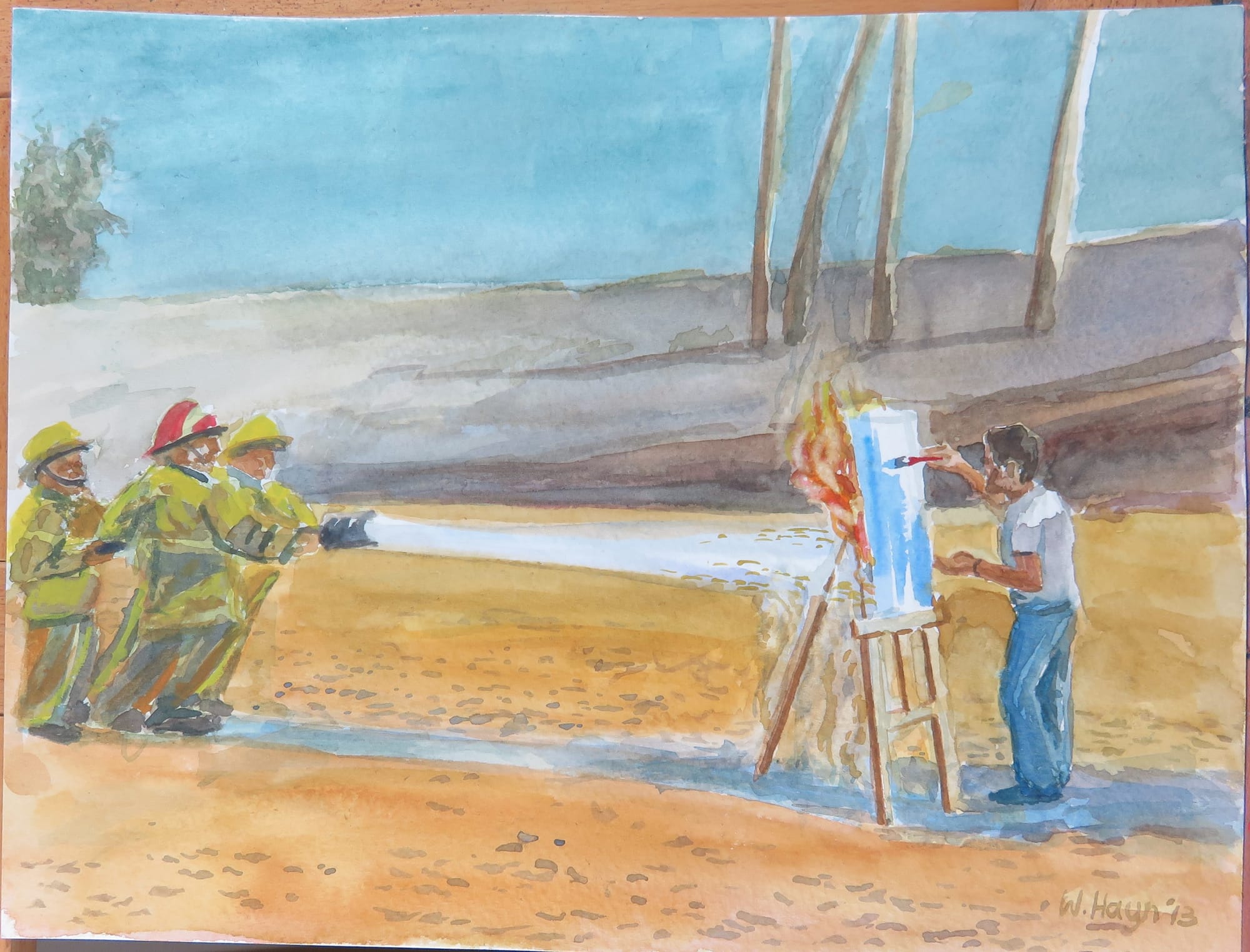
Shortly after the studio residency in 1996 I had my first solo show of paintings in a gallery in Durban, and then, rather unexpectedly, newly married, in 1997 moved to England and settled in Penge, London. Paying the mortgage and the heating became a priority, and so I descended into a spiral of mundane jobs while my artistry was largely neglected.
Although I began to exhibit regularly in group shows, (with my local supportive band of artists, the ‘SE20 Group’, in Penge), I struggled to find the time or momentum to make satisfactory progress in my art. Finally, in 2009, I took a leap of faith and returned to university, where I achieved a PGCE and an MA in art and design education. Becoming a part-time school art teacher paid for time to paint, and for over six years I have been working from a studio in Penge which is at the top of a church tower - it’s a marvellous space with 360 degree light from the windows all around. Over this time I have been experimenting and painting with black and white silicone rubber on stretched canvas- and have discovered a technique that I think is finally working. In a celebratory mood I recently showed my newest paintings using silicone rubber in an exhibition entitled, ‘The Song of the Coelacanth’, at Jeannie Avent Gallery in East Dulwich. (August 2025.)
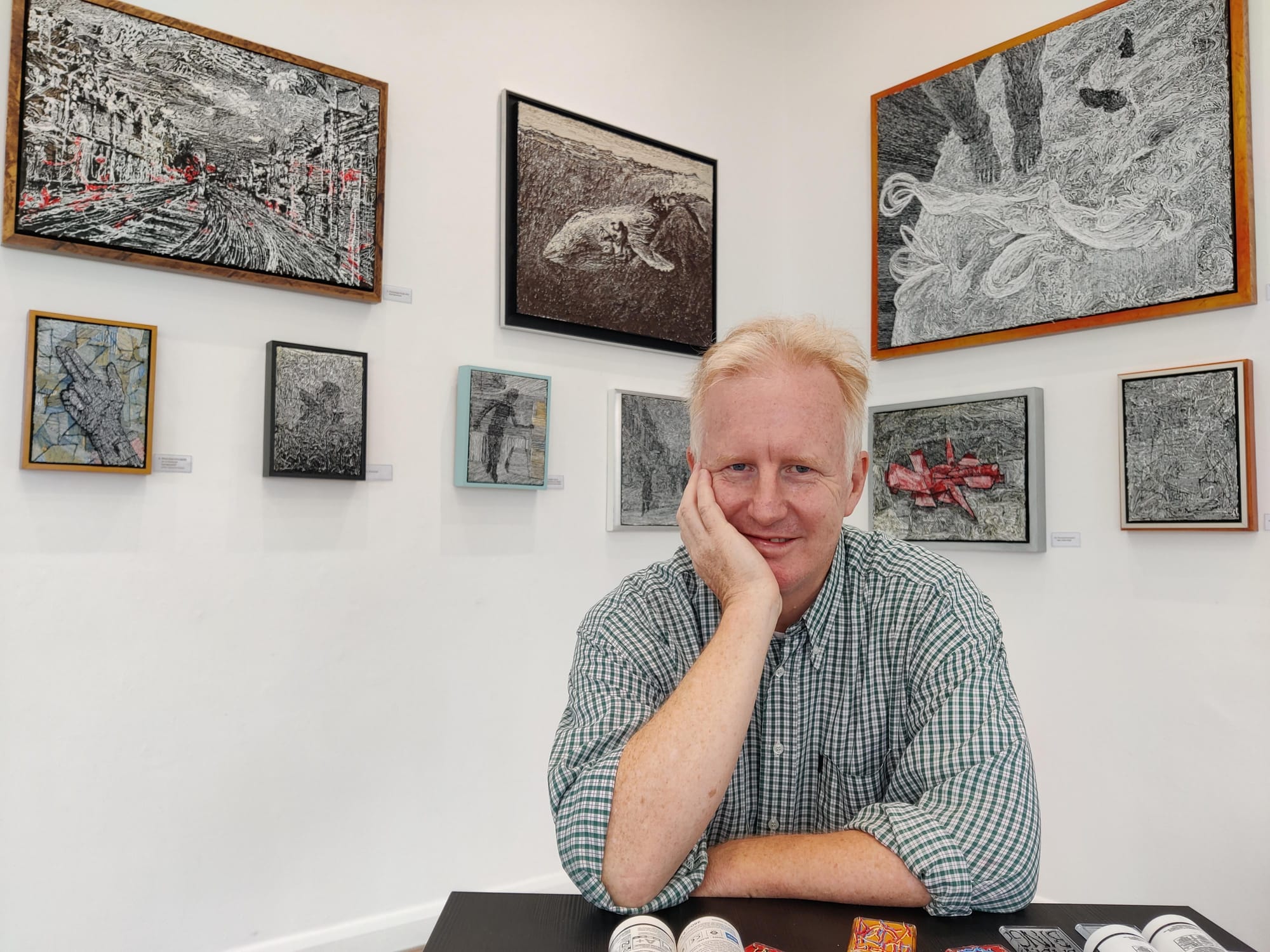
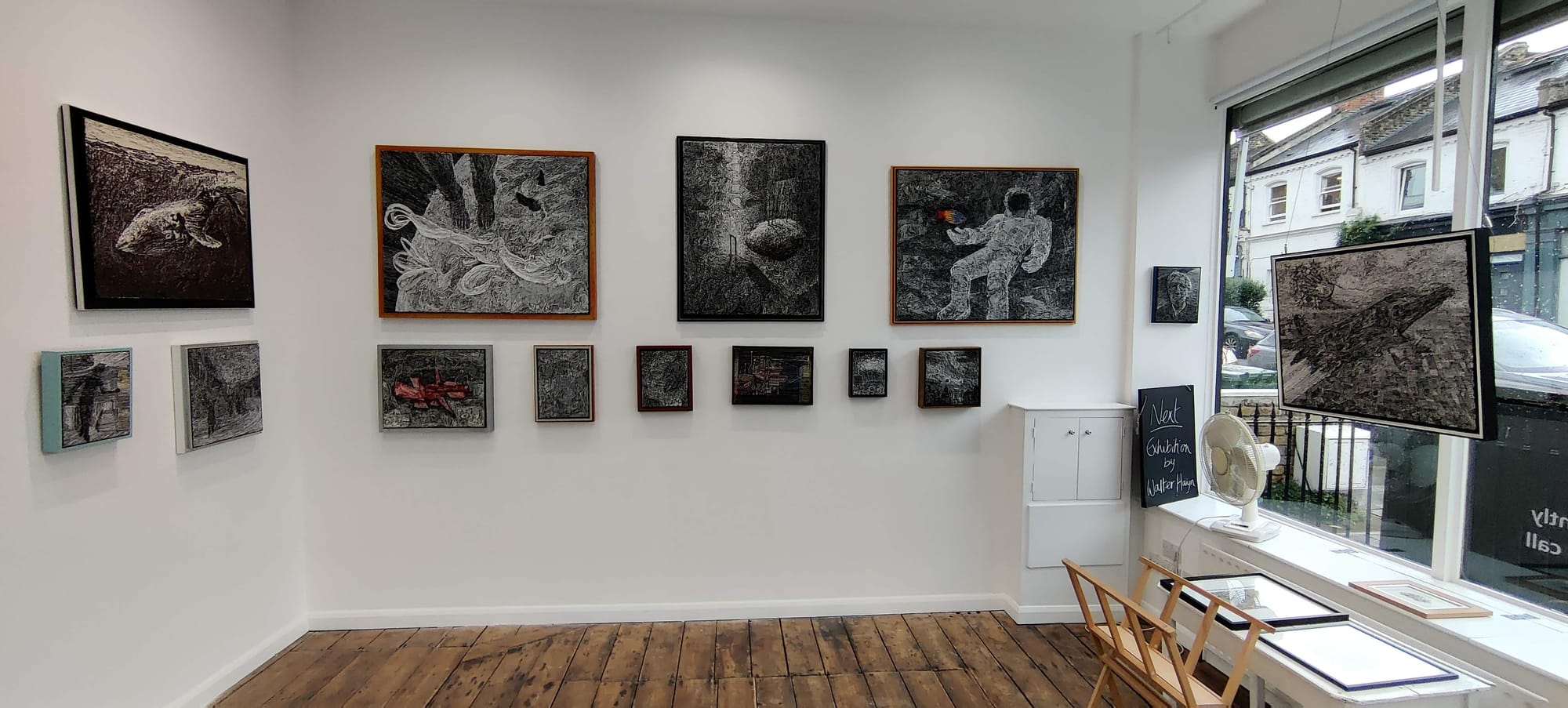
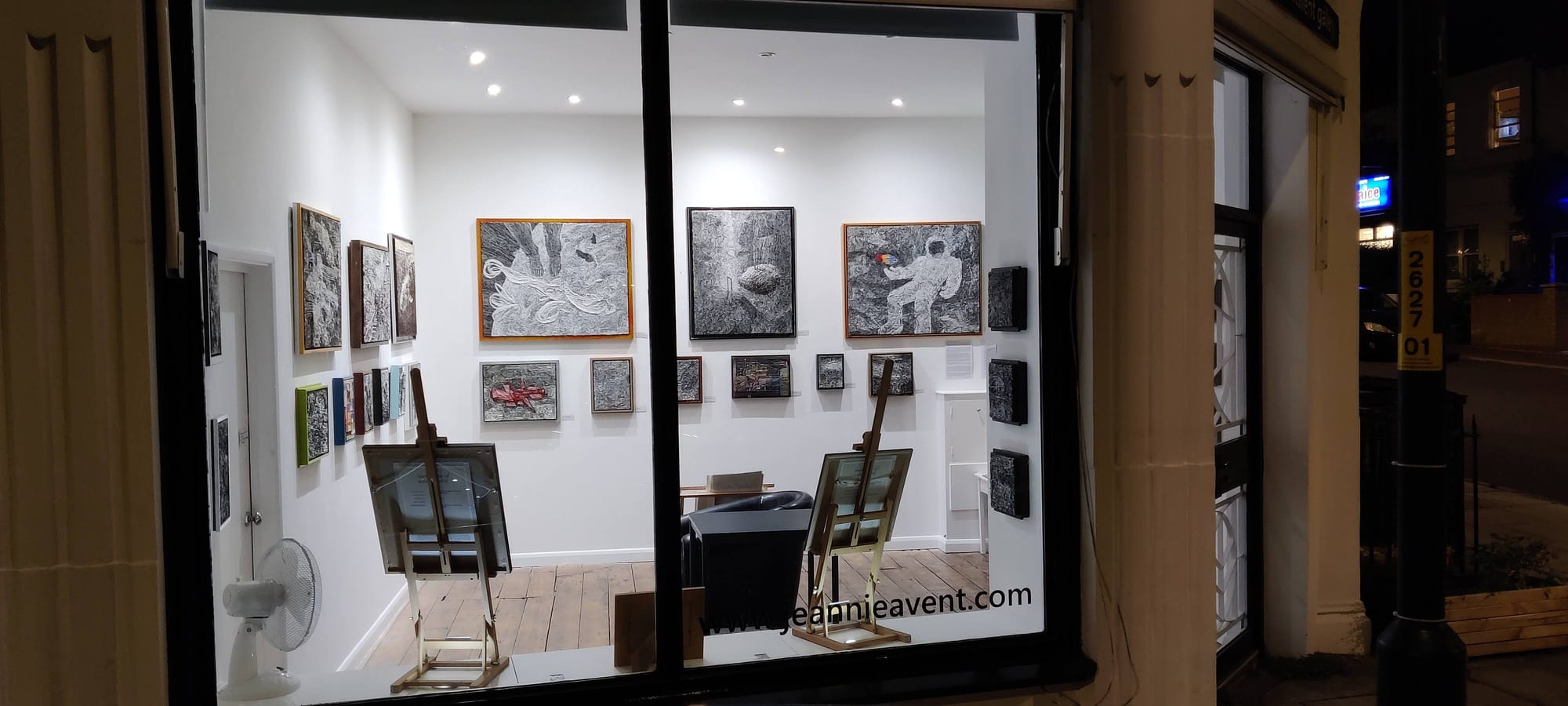
You have worked in anonymity, to a degree, for over a decade and now you are bringing your work to light. Was this a gradual process, or was there an inflection point when you decided to open these dreams up to the world?
In the years up to about 2012, I had been doing oil, acrylic and watercolour paintings, but looking back, I don’t think I ever found conventional painting natural to me. This an interesting topic: Why is it that some artists work in metal, and others in clay… or photography? I think most artists have a certain affinity with a material or medium that they need to use, and it is important for them to discover that medium. When I stumbled on silicone rubber as a painting medium I gradually abandoned my ‘normal’ paintings and drawings as I worked to refine my use of silicone. My early efforts were very raw and there were challenges to overcome. At various intervals I thought that my work was ready to exhibit, but decided against ‘rushing it’, and persevered with older pieces I had begun years earlier. I wanted to discover how far I could push the medium. Then, about a year and a half ago I reached the point where paintings I was working on started to ‘sing’ to me. That was when I knew that I had better start looking for an exhibition space.
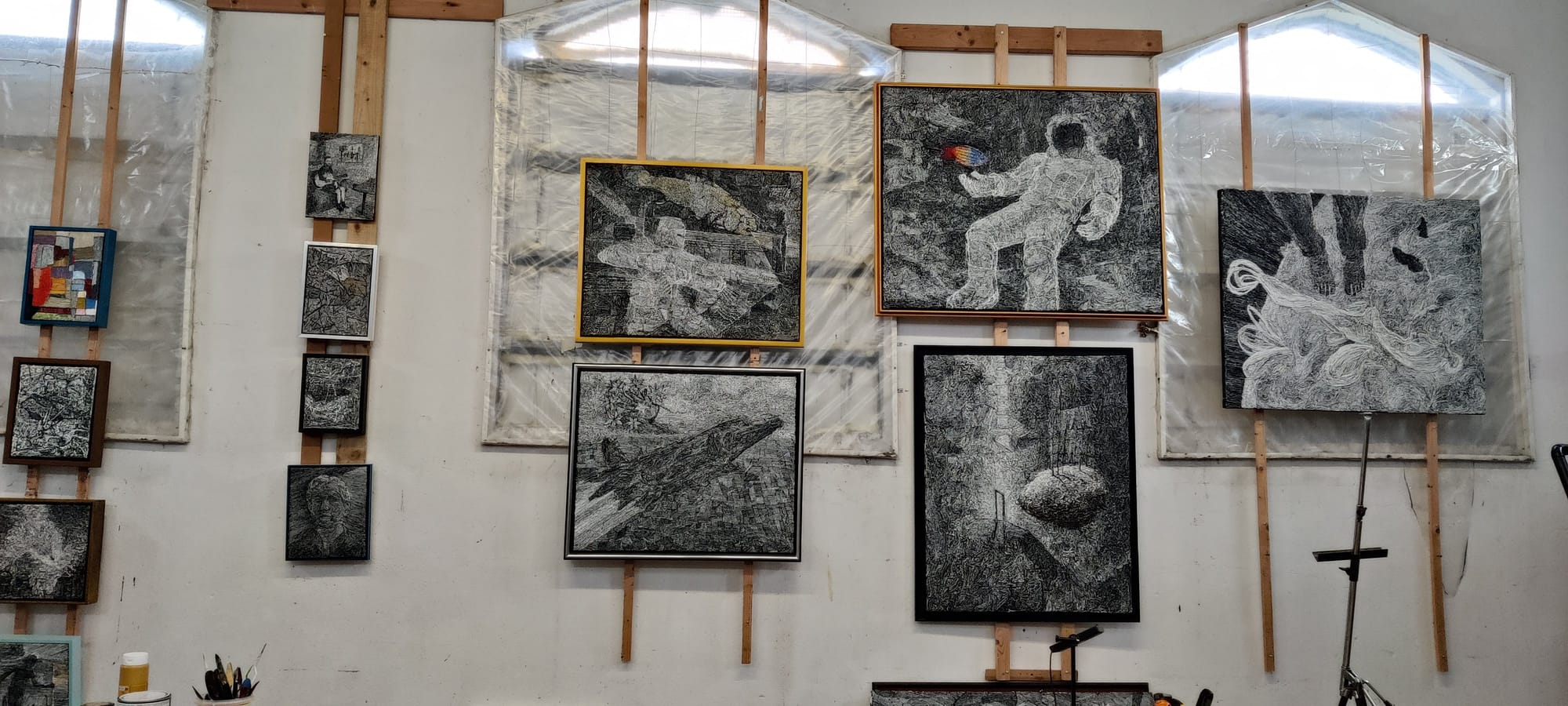
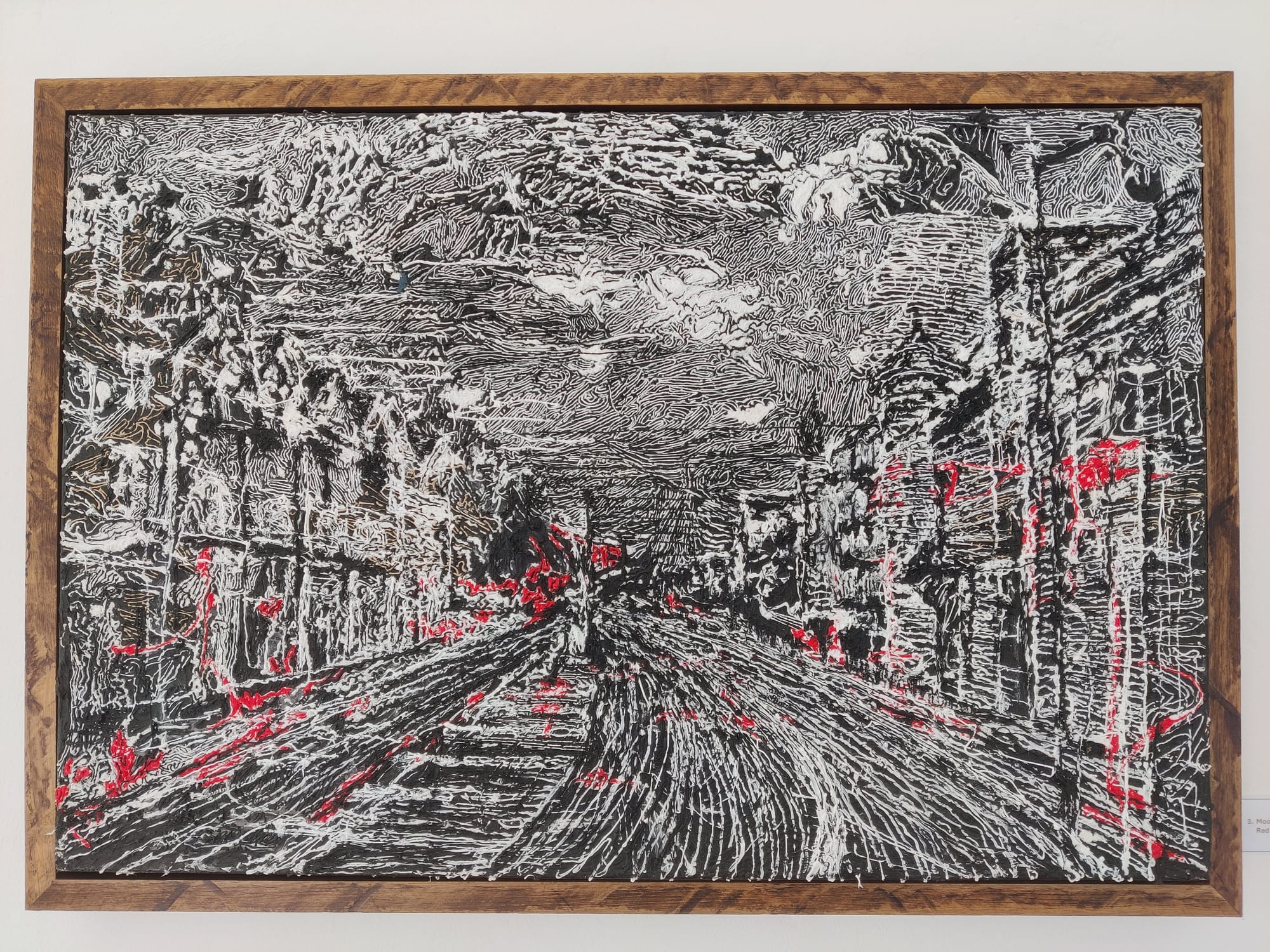
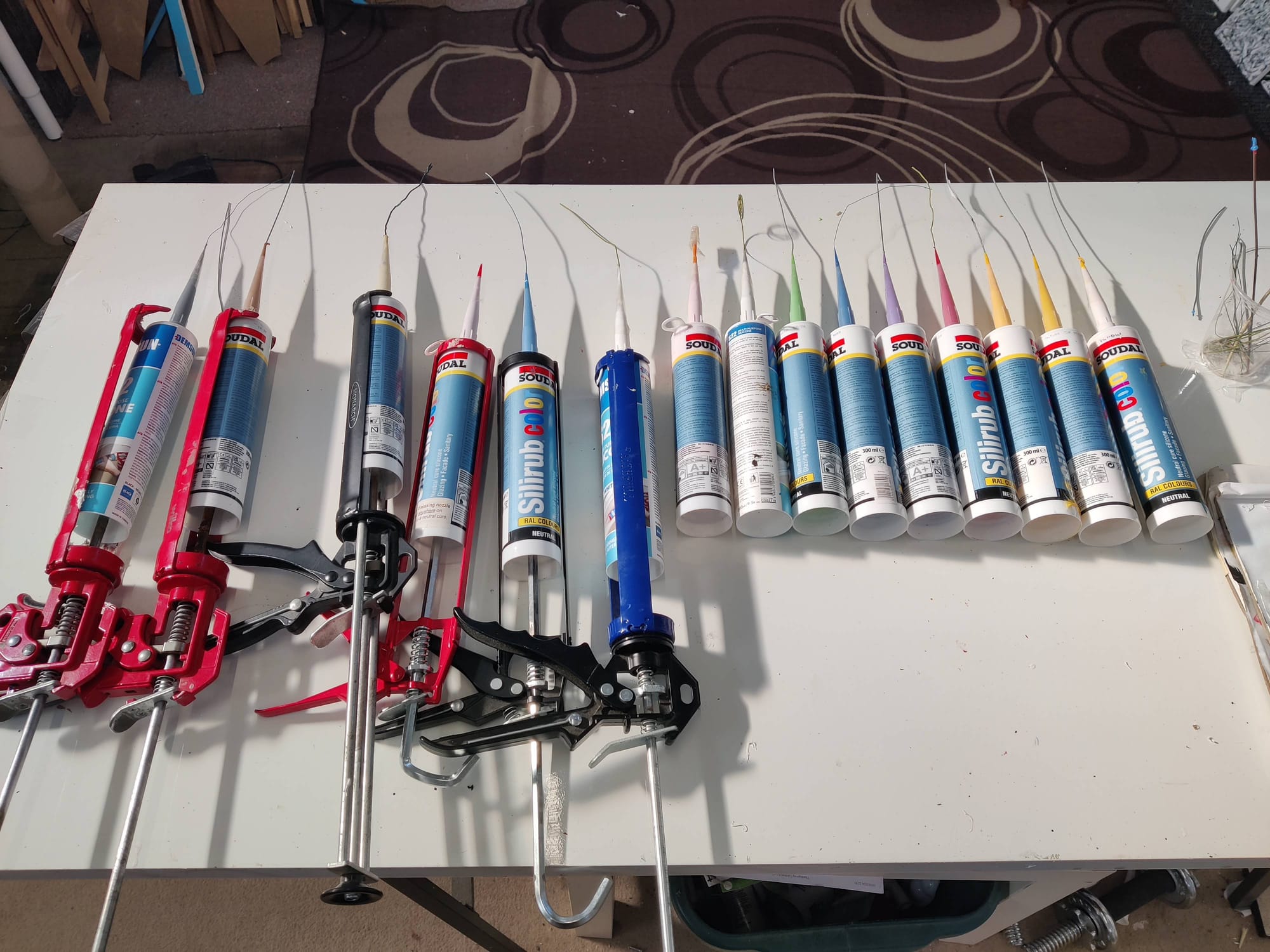
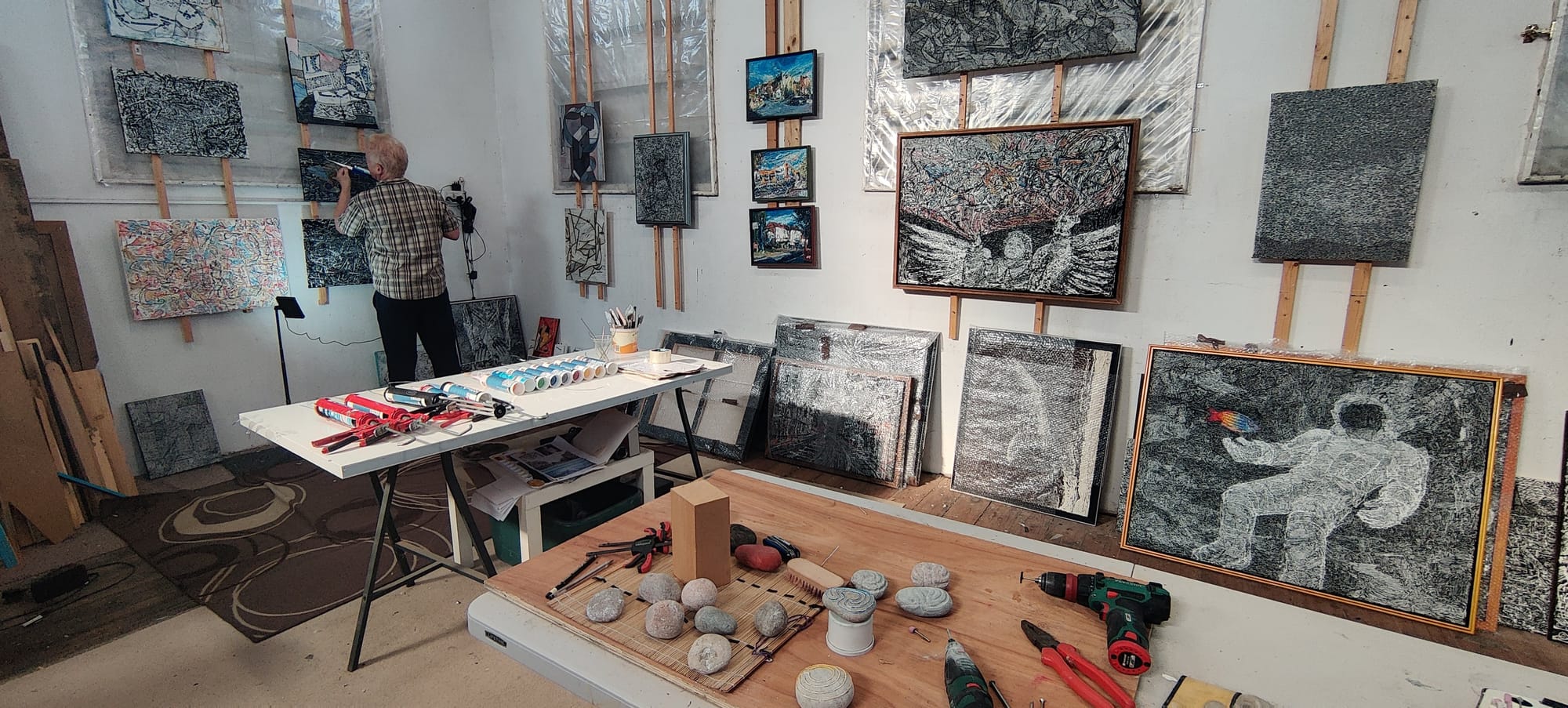
The sea, depth and the mysteries of the past play a key role in your work – blacksmiths inside whales, astronauts witnessing fish in space and the miraculous coelacanth. Can you talk to us about this connection with the deep and how you work with it?
About fifteen years ago I reached a crisis point. Things in my personal life were in turmoil, and at least part of that pain I attributed to the fact that I hardly ever found time to make art any more. I had descended into depression from doing paid work that simply didn’t inspire me. Around that time I found encouragement in the Biblical story of ‘Jonah and the whale’. In the same way that Jonah tried to run from God’s command, so I had been running from my calling to make art. Jonah had to surrender to the sea where a large fish swallowed him, and there, in the belly of the fish he then came to terms with his identity and calling. In my ‘Murmuring Deep’ painting, Jonah inside a whale, hammers out a large key on an anvil, and this key will presumably unlock his fears and doubts and set him free. In the same way I also had to surrender my notions of success and the expectations placed on me. I had to dig deep to confront my failings… and my ‘key’ was to begin making art again.
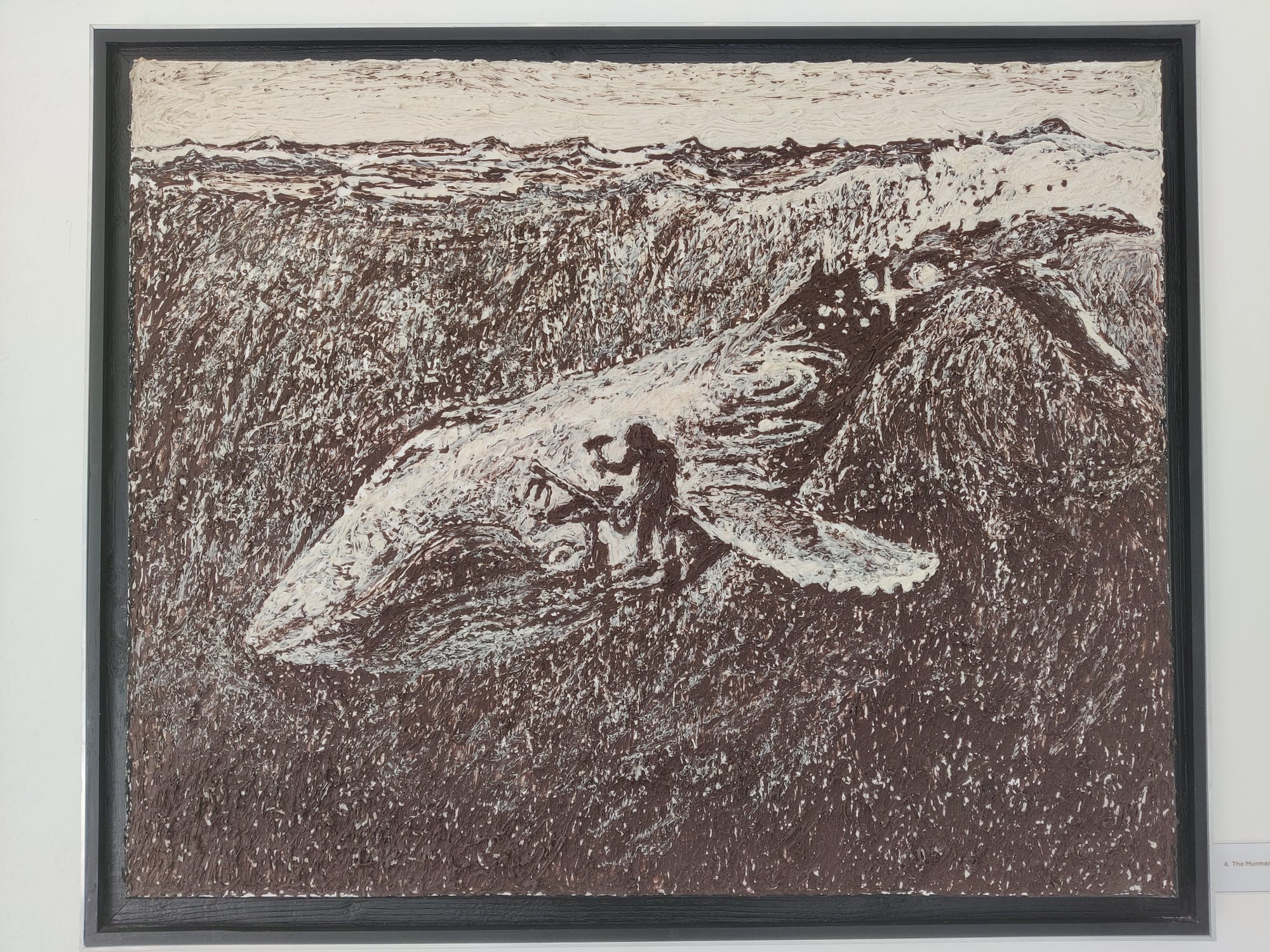
The other aspect of ‘the deep’ is that, in a painting I can explore any environment that I choose; the only limit being my imagination. My enjoyment of science-fiction movies comes into play, as well as the medium of silicone rubber itself. Silicone rubber was developed by NASA for use in space and now it is used in almost every product that requires a flexible airtight or watertight seal, from kitchen sinks to deep-sea equipment, and vessels in deep space. It seems appropriate that I use silicone rubber as a medium to explore the oceans - and the deepest recesses of space.
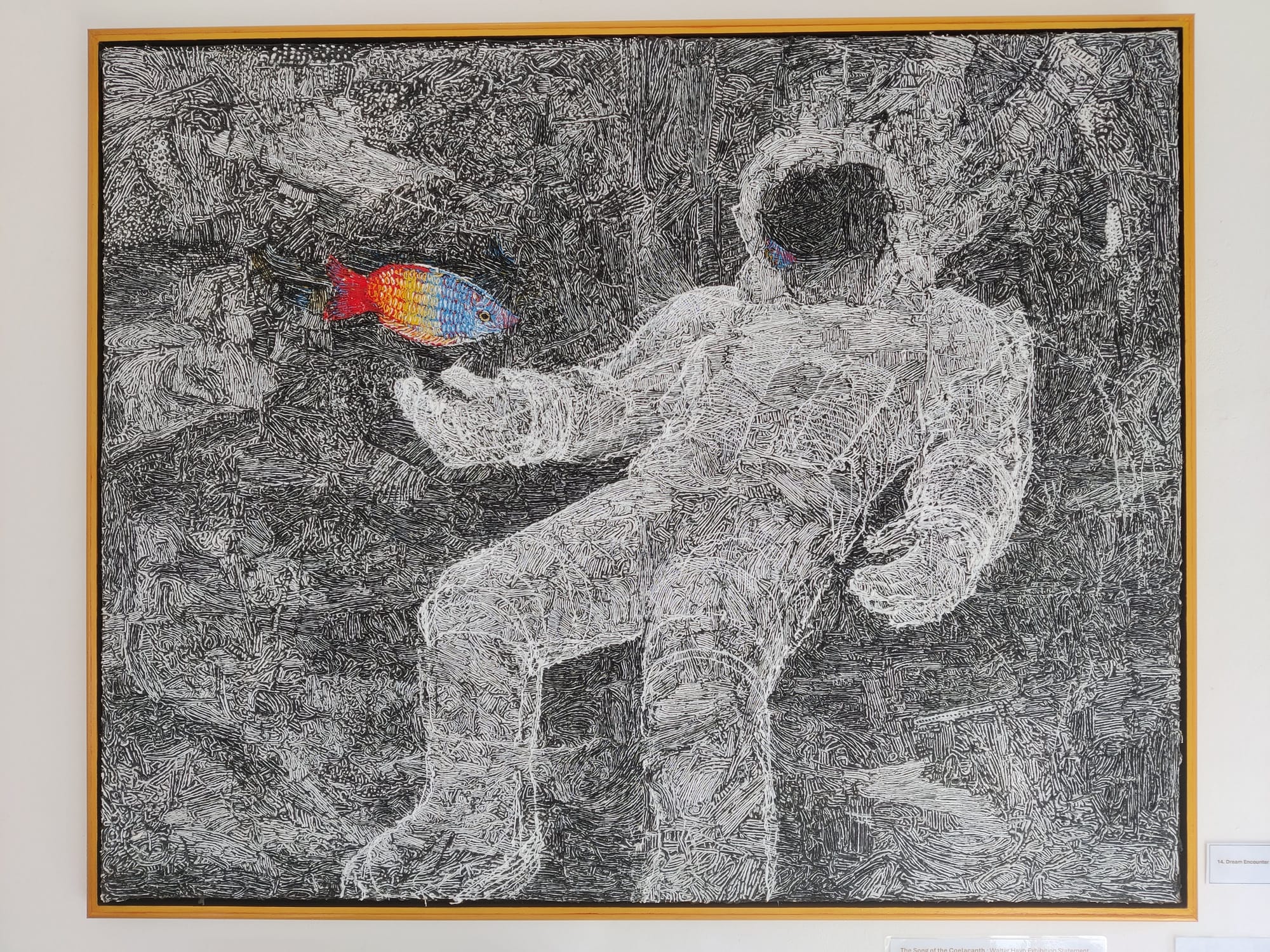
Using silicone – it’s such a readily available material, it’s almost a household implement. Was this a conscious choice, or did it happen by accident
I was in-between jobs, around 2013, doing a stint of paid decorating work which included kitchen and bathroom repairs, when the variety of glues, fillers and sealants that I was using sparked my imagination. “Why not use them to make art?” I thought. Soon afterwards while shopping in Lidl I saw a shelf containing eight tubes of bitumen (for gutter repairs) at a discounted price, and so I bought them all and began to paint with them. The bitumen turned out to be smelly, and not very stable, but I liked the way I was able to ‘draw’ with it. This turned my attention to the spare tubes of silicone rubber I had in my toolbox. I first tried spreading the silicone with a palette knife, scraping into it, and drawing with it, but my first attempts were very rough, so I chose to omit colour altogether to focus on the tonal aspects of just using black and white silicone. You see, black silicone rubber is incredibly dense as is the white silicone, and this way of painting - with the two tonal ‘polar opposites’ became very interesting to me, perhaps because it mimicked my pen and ink drawings - although on a much more complex level because it included the element of texture - and the use of white, where in an ink drawing the white of the paper is the only ‘white’ available. Some of my big paintings are unexpectedly heavy because they have become so worked and layered over the years. I think artists like Frank Auerbach and Leon Kossoff who painted thickly and slowly reworked their canvases, encouraged my work in this way.
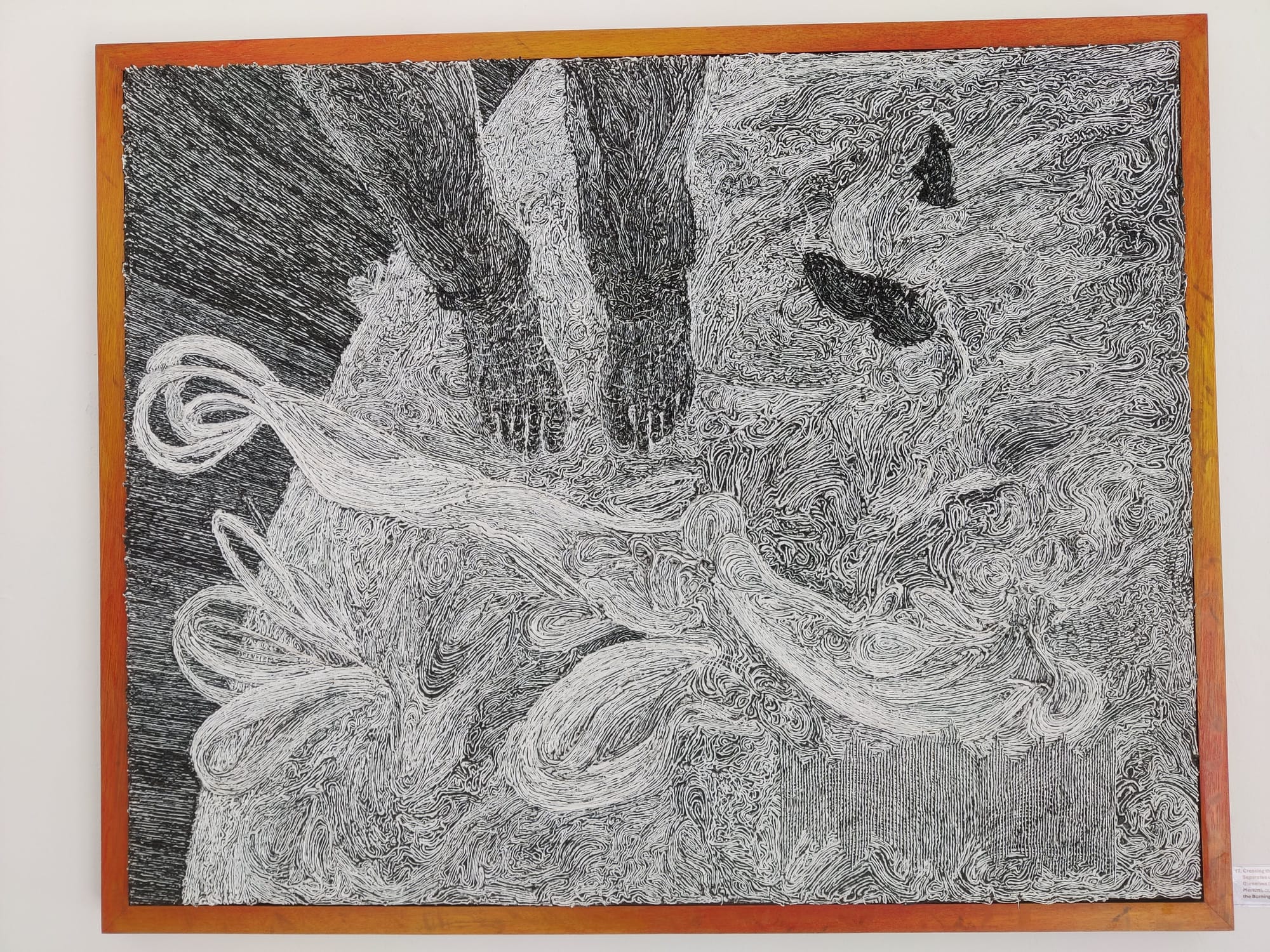
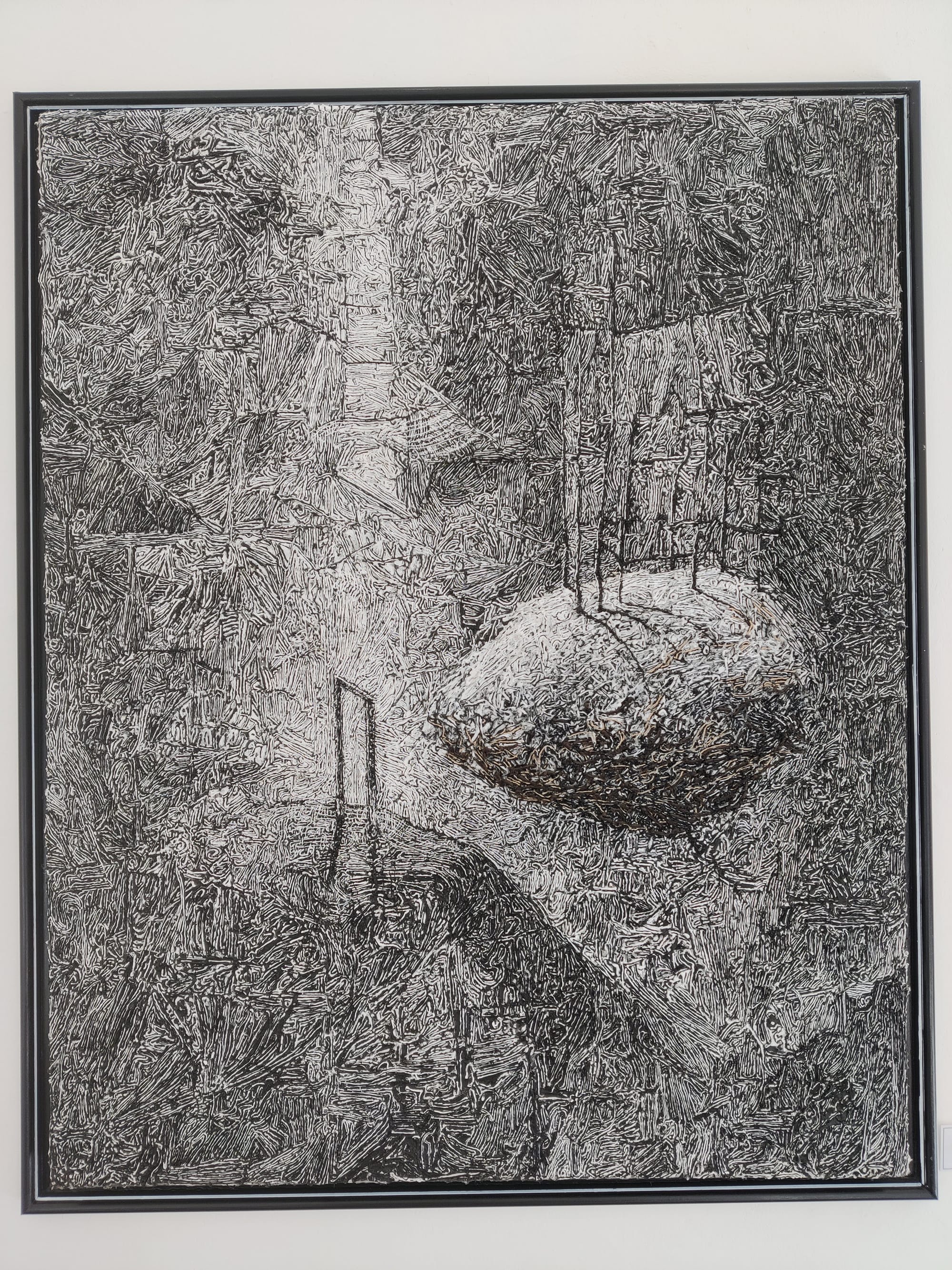
What have people’s reactions been when they learn of your technique and tools?
Having a body of work on show at Jeannie Avent recently was very helpful in terms of feedback about my use of silicone rubber. One of the best reactions happened when I was in the gallery one morning a few days after the opening preview. A man walking by on his way to work, stopped in the doorway, and holding a thumb up to me said; “Mate, I would buy every one of your paintings if I could. I’m a builder and I just love what you’re doing!” The man explained that he had enjoyed seeing my work in the lit gallery on his way home the night before, and that silicone rubber was a material that he was very familiar with. Other visitors to the gallery at first thought that they were seeing embroideries, like tapestries, and a few others asked if I was using thin telephone wire. When people discover that I am using silicone rubber to make the paintings, they are appreciative and sometimes amazed. Especially if they have tried to apply silicone (which can get very messy) around the edges of their tiled showers or kitchen sinks themselves!
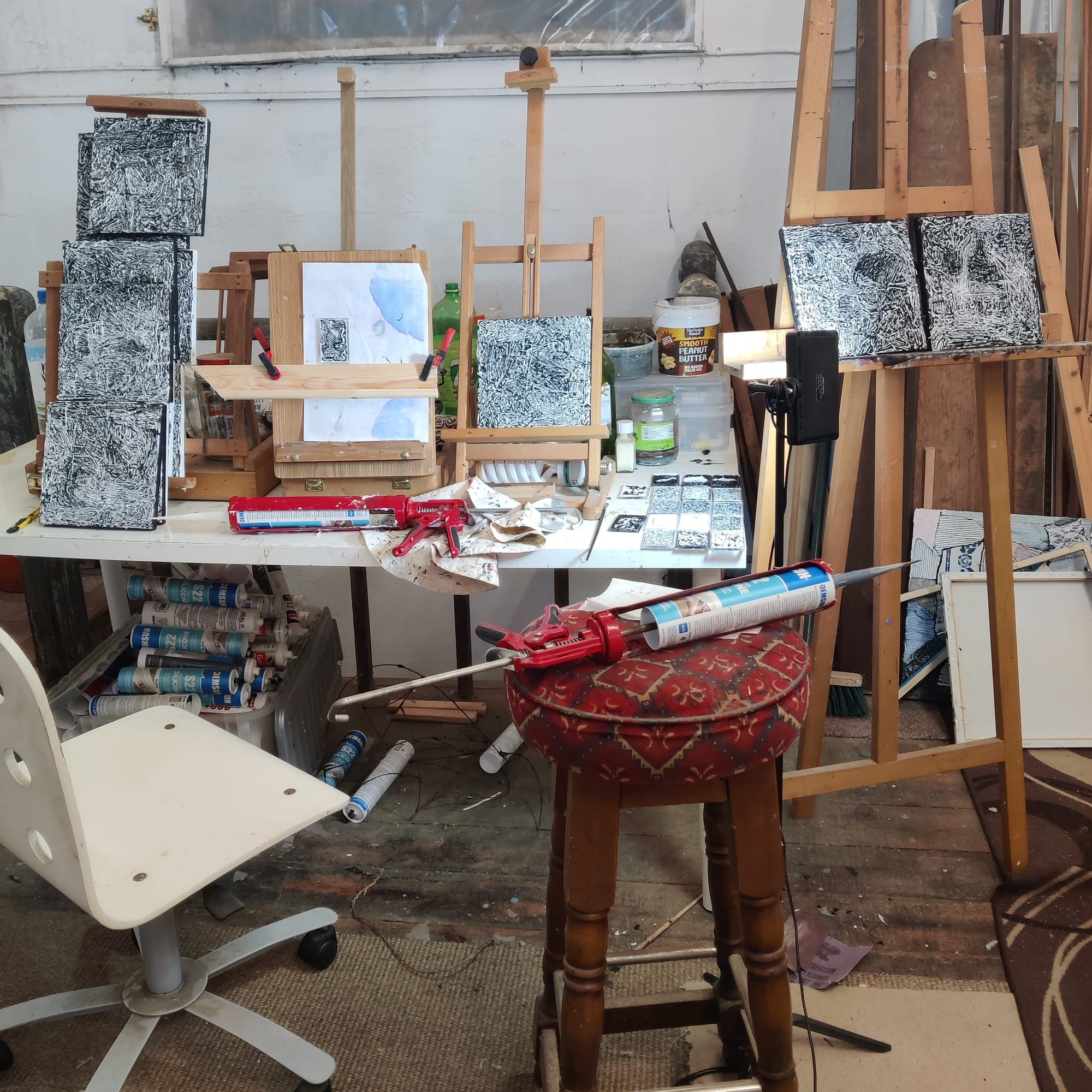
Do you start at a place of pre-determined abstraction, or does the progression of the piece lead you to a certain place?
Many of my paintings with figurative elements begin as abstract paintings, and then, a bit like a person who stares at a cloud and starts to see a tea-pot or a dragon, I begin to see a figure or an object emerging out of my ‘cloud’ of marks on the canvas before me. (Making a painting like this is a bit like grasping around for your glasses in a dark room.) Then I develop and bring into focus the hazy image that begins to emerge. I have the privilege of inhabiting a large studio space, and can have five or six paintings on the go at the same time - so I work on one painting until I don’t know how to progress, and then jump to another one. This way of working allows a lot of looking and thinking. I don’t ‘force’ a piece, but wait until I can intuit a way forward.
Your work, for us, is somewhat impressionistic and dreamlike – especially in its imagery, and there are also elements of surrealism and post-war abstract expressionism. Are you aware of what you’re leaning in to, or exploring when creating?
People have pointed out that certain of my pieces remind them of Paul Klee, and others have mentioned Anselm Kiefer. I am not unhappy about this, as these are artists who I have looked at extensively. There are many others who inspire me too. I am never consciously thinking about other artists or styles when I paint, but when I do a landscape painting, Kiefer might pop to mind, and when I have worked on a diffused portrait, Gerhard Richter might come to mind. Knowing their work guides me at various stages but I will veer away from looking too similar to another artist or movement in art. I want my work to look like ‘me’ as much as possible. The artists I admire, along with the good (and troubles) in my personal history; my faith in Christ, and themes of the Bible, mix together like compost, and out of that I try to make something new grow.

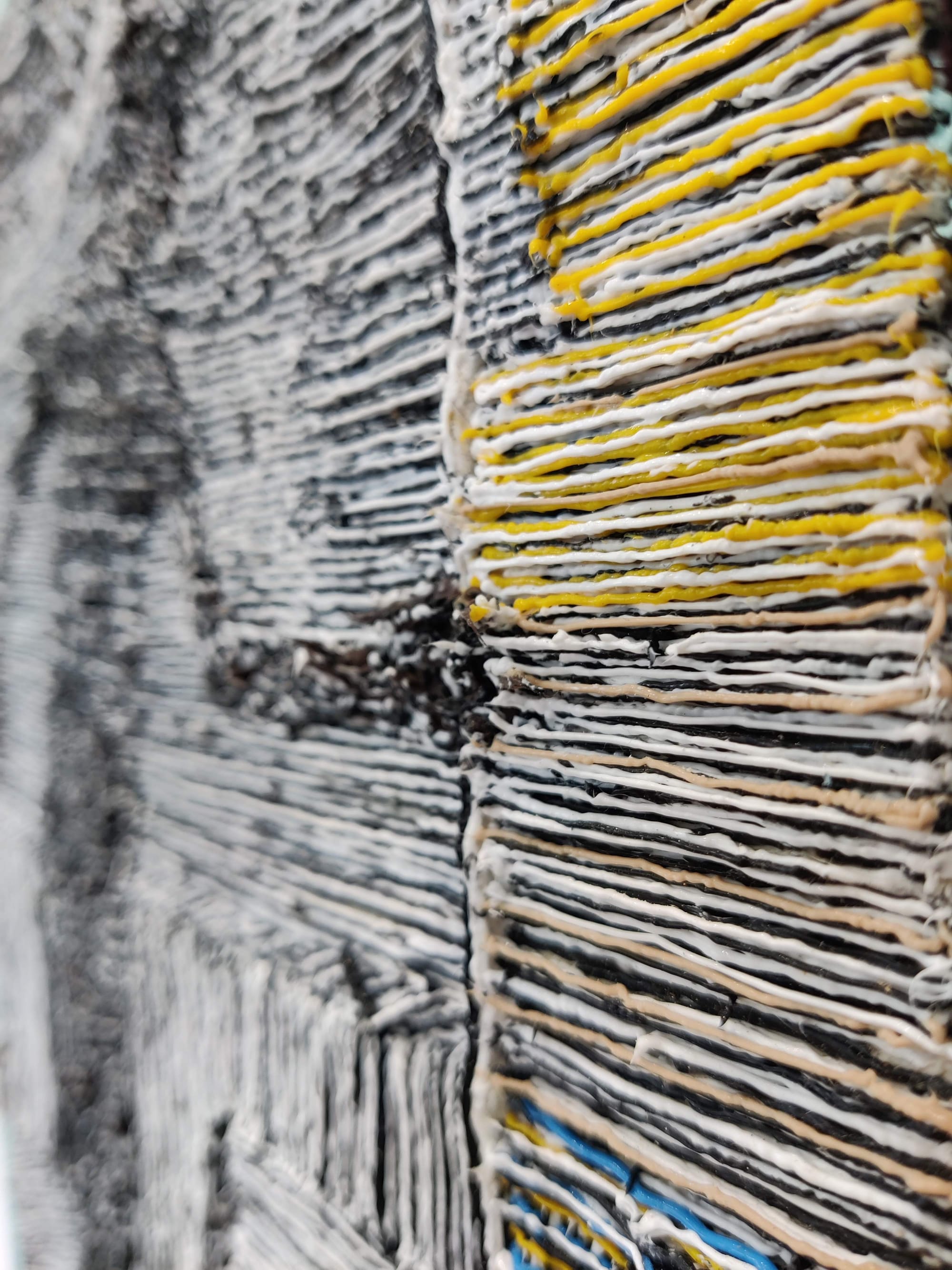
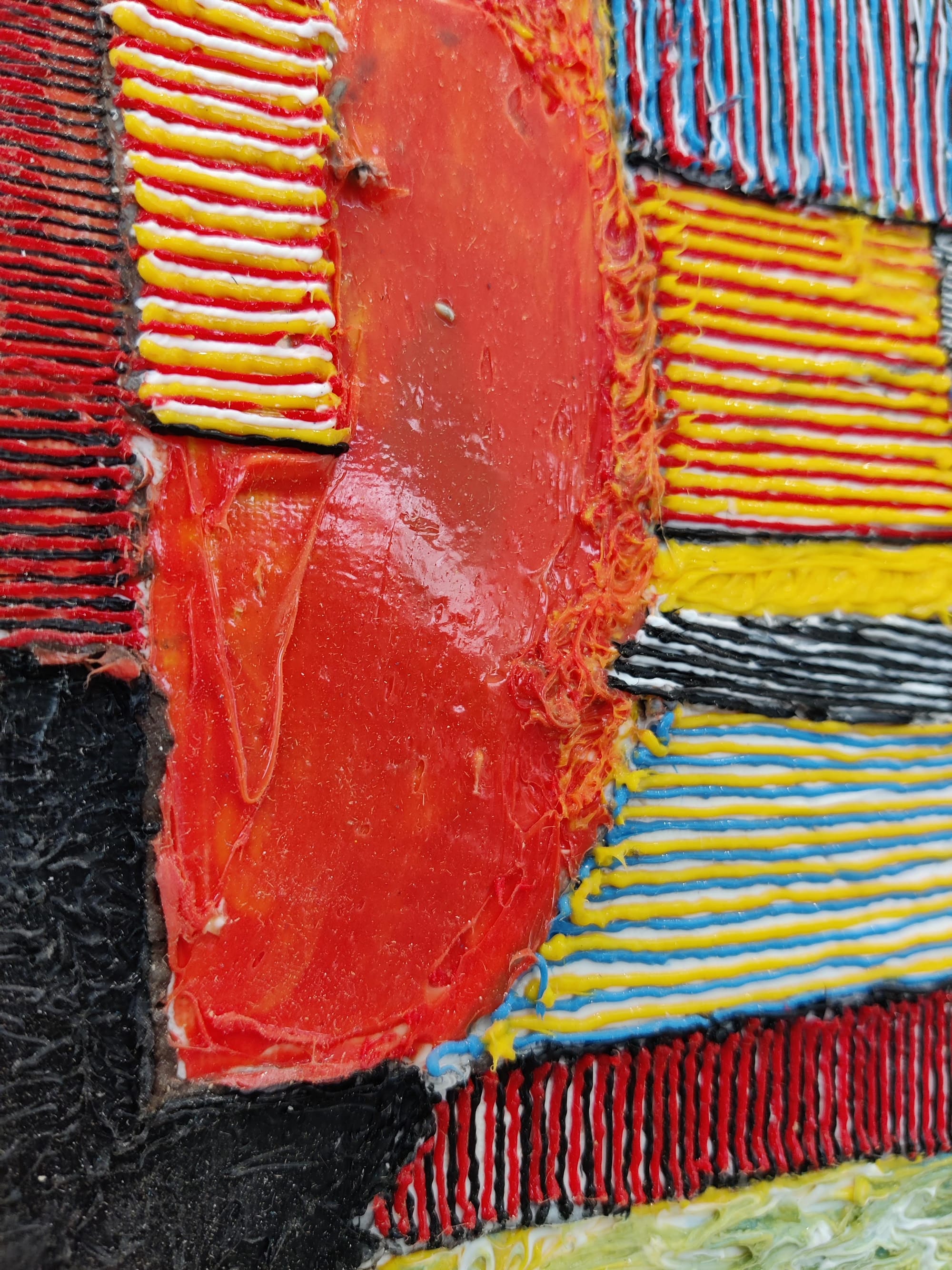
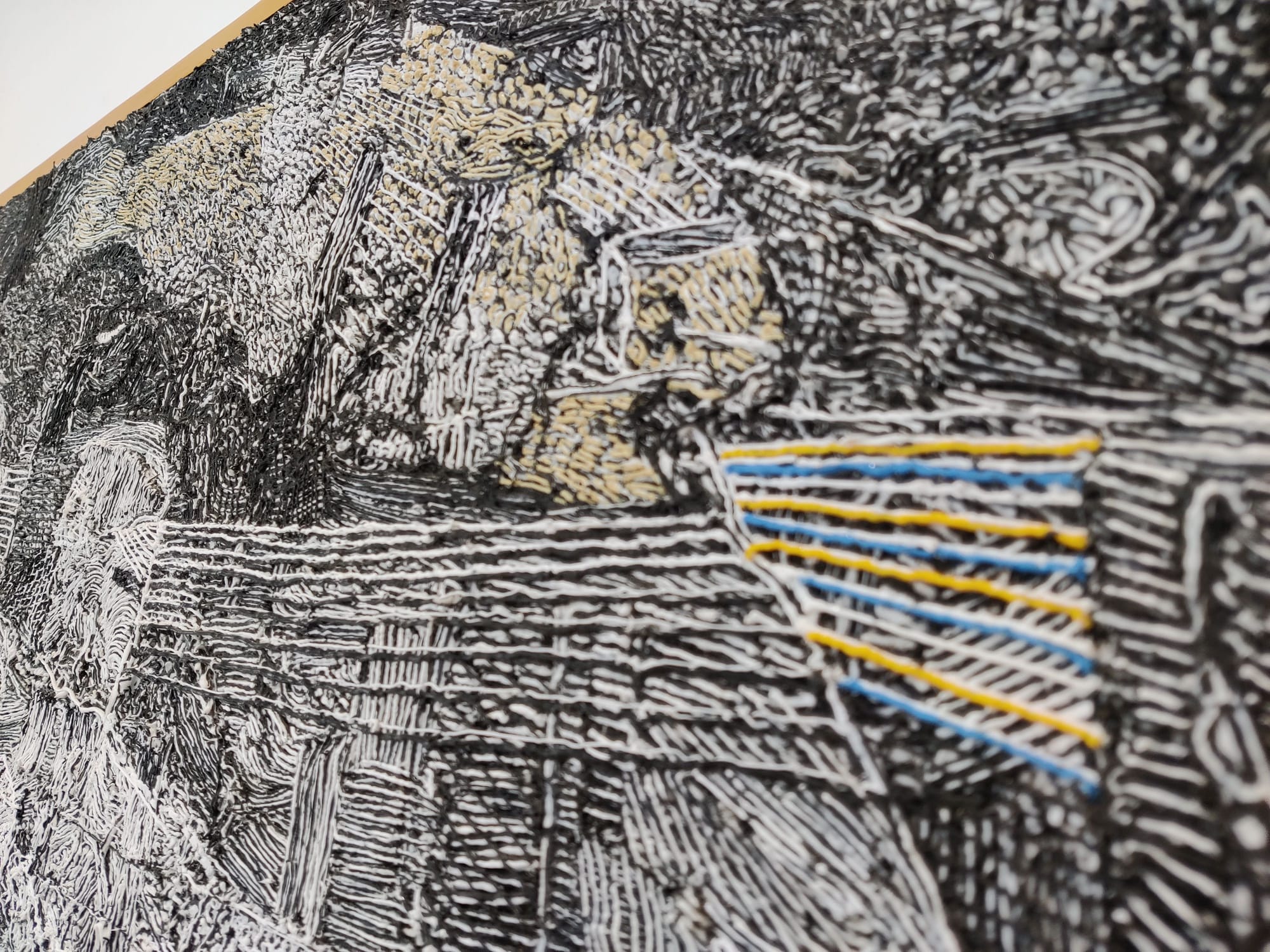
Creativity requires a deep level of thought and commitment – how do you balance that with day to day life?
I have a couple of sources of paid employment, including my teaching job - and family and friends are important to me too, but I try to get into my studio every day. Even after a long day in the classroom teaching art. After supper I’ll take a cup of coffee up to my studio, and just sit and look. Sometimes I’m too tired, but most of the time I see something that needs tweaking in a painting, and then before I know it, a couple of hours have slipped by. I have a mantra that goes through my head when I’m feeling lazy; ‘every hour counts’. I love watching movies which inspire my art, but it’s a very passive and unproductive past-time, as is the occasional ‘doom-scrolling’ on my phone.
Your voice – was it there from the start, or is it an ongoing quest to discover and define it?
When I was younger I really didn’t know if I had a ‘voice’ or not. I just knew that my work was not very satisfactory, and I kept experimenting with different styles and subject matter. A good friend said to me once that my jumping around stylistically and thematically from painting to painting was at once my greatest strength, and also my greatest weakness. I think that the dissatisfaction I had with ‘normal’ painting also emphasised the apparent disharmony in my work. However, since I have been using silicone rubber, my body of work has become much more cohesive than it ever was before.
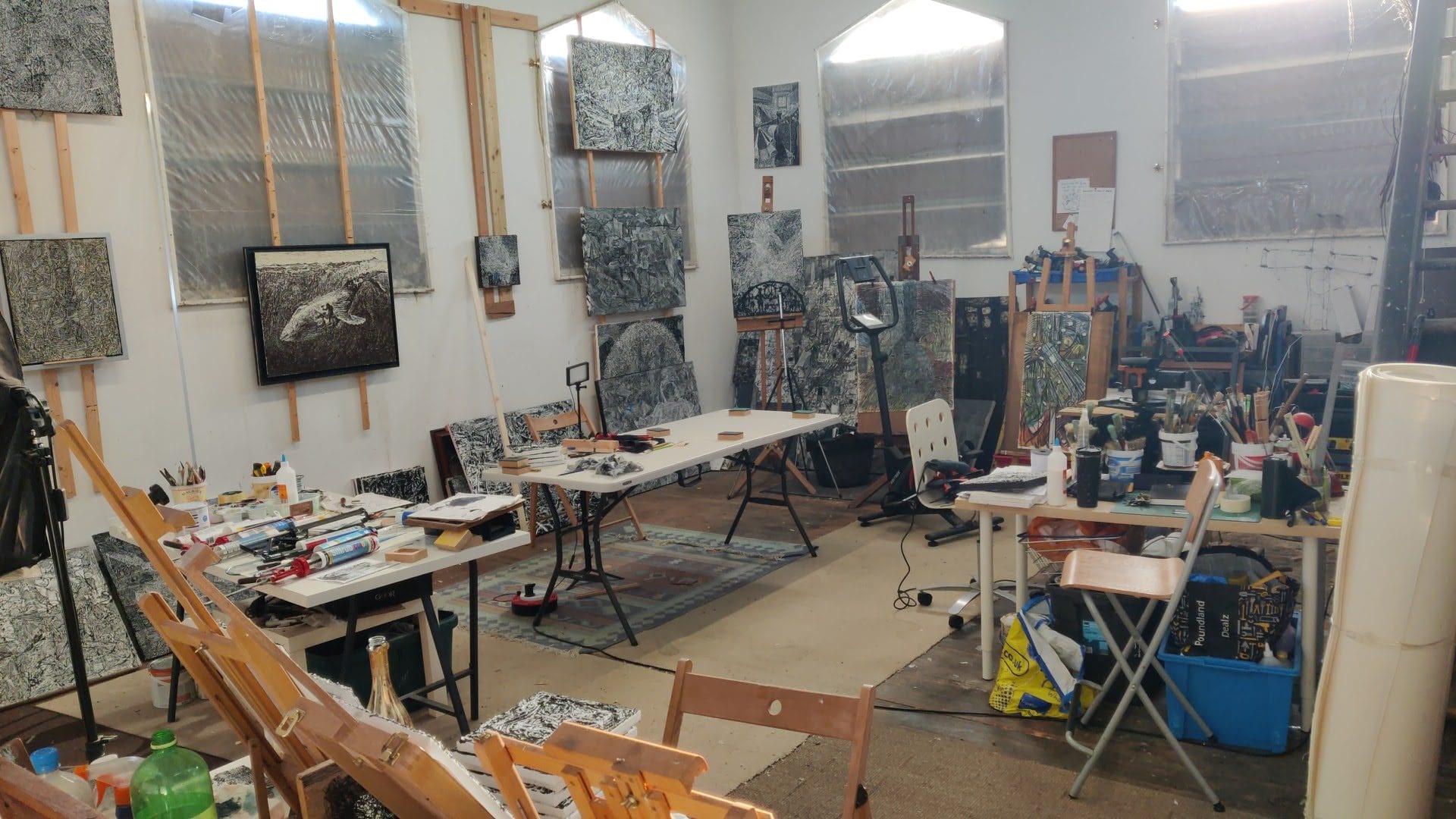
How can art help us?
I think art helps everyone differently. I can only speak as an artist, and bearing my own journey in mind, I think I am incredibly fortunate to be an artist. Making art has helped me to celebrate so many good things in my life, but also helped me to come to terms with many difficult things. I sometimes wonder how people who don’t practice some form of creative expression cope!
Nothing ever goes to waste.
What advice would you give to anyone out there who is starting out on their art journey.
When I was in my twenties, a good friend, South African sculptor Gert Swart, asked me, ‘Do you want to be an artist?’. I had to think for a moment before saying ‘Yes’. There is no excuse for not making art in our privileged Western society. Even if you’re an accountant just carrying a sketchbook around with you, or using your finger to draw on your phone, you’re an artist! As in my own experience, I would say, don’t be too ambitious. Just do a small thing that you can for the moment, and keep doing it. It will soon add up. A full-time teacher colleague of mine struggled to find time to paint, but he was drawing fellow passengers on the train to school every day. When he showed me the dozens of amazing drawings that he had done, I was impressed. He had a whole body of work ready to exhibit!

We're constantly on the look out for new artists, creatives and initiatives to feature in TheNeverZine - so if you are, or know someone who is going their own way and doing their own thing on their own terms and would be a good fit to feature please smash that button below and get in contact. By talking to each other, and sharing our journeys, ideas and insights on creativity, art, mental health and resilience we can all create, share and thrive together. Nice thought that.
PS - Don't forget to subscribe below for more content from TheNeverPress 👇

